中国文化外译-颜色
- 格式:doc
- 大小:43.00 KB
- 文档页数:3

英汉颜色词的文化内涵及其翻译
颜色词在各种文化中都具有特定的文化内涵,不同文化对颜色的理解和象征意义也有所差异。
以下是一些常见的颜色词及其文化内涵和可能的翻译:
1. 红色:在中国文化中,红色象征着喜庆、幸福和热情。
红色在中国传统婚礼、春节和其他庆祝活动中非常常见。
翻译时可以直接使用"red"。
2. 黄色:在中国文化中,黄色象征着皇室和尊贵。
黄色也经常与土地和秋天相关联。
翻译时可以直接使用"yellow"。
3. 蓝色:在西方文化中,蓝色通常表示冷静、清新和安宁。
在中国文化中,蓝色与水相关联,也经常用来表示温柔。
翻译时可以直接使用"blue"。
4. 绿色:在西方文化中,绿色象征着自然和健康。
在中国文化中,绿色也与自然和幸运相关。
翻译时可以直接使用"green"。
5. 黑色:在西方文化中,黑色通常表示悲伤、丧失和死亡。
在中国文化中,黑色也常用来表示权力和尊重。
翻译时可以直接使用"black"。
6. 白色:在西方文化中,白色通常象征着纯洁和无辜。
在中国文化中,白色经常与丧礼和哀悼有关,表示悲伤。
翻译时可以直接使用"white"。
需要注意的是,虽然颜色词的基本意义可以直接翻译成英语,但在具体的语境中,颜色词可能会有不同的文化内涵和象征意义。
在翻译过程中,应根据具体情境选择合适的译法,同时了解目标语言读者的文化背景。



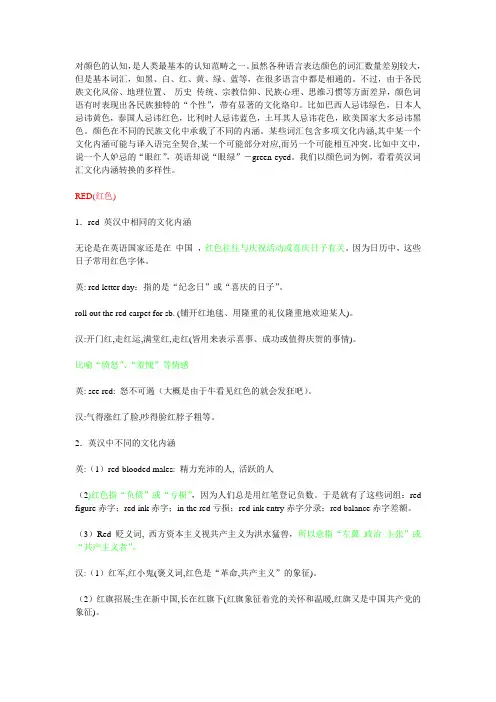
对颜色的认知,是人类最基本的认知范畴之一。
虽然各种语言表达颜色的词汇数量差别较大,但是基本词汇,如黑、白、红、黄、绿、蓝等,在很多语言中都是相通的。
不过,由于各民族文化风俗、地理位置、历史传统、宗教信仰、民族心理、思维习惯等方面差异,颜色词语有时表现出各民族独特的“个性”,带有显著的文化烙印。
比如巴西人忌讳绿色,日本人忌讳黄色,泰国人忌讳红色,比利时人忌讳蓝色,土耳其人忌讳花色,欧美国家大多忌讳黑色。
颜色在不同的民族文化中承载了不同的内涵。
某些词汇包含多项文化内涵,其中某一个文化内涵可能与译入语完全契合,某一个可能部分对应,而另一个可能相互冲突。
比如中文中,说一个人妒忌的“眼红”,英语却说“眼绿”-green-eyed。
我们以颜色词为例,看看英汉词汇文化内涵转换的多样性。
RED(红色)1.red 英汉中相同的文化内涵无论是在英语国家还是在中国,红色往往与庆祝活动或喜庆日子有关。
因为日历中,这些日子常用红色字体。
英: red letter day:指的是“纪念日”或“喜庆的日子”。
roll out the red carpet for sb. (铺开红地毯、用隆重的礼仪隆重地欢迎某人)。
汉:开门红,走红运,满堂红,走红(皆用来表示喜事、成功或值得庆贺的事情)。
比喻“愤怒”、“羞愧”等情感英: see red: 怒不可遏(大概是由于牛看见红色的就会发狂吧)。
汉:气得涨红了脸,吵得脸红脖子粗等。
2.英汉中不同的文化内涵英:(1)red-blooded males: 精力充沛的人, 活跃的人(2)红色指“负债”或“亏损”,因为人们总是用红笔登记负数。
于是就有了这些词组:red figure赤字;red ink赤字;in the red亏损;red-ink entry赤字分录;red balance赤字差额。
(3)Red贬义词, 西方资本主义视共产主义为洪水猛兽,所以意指“左翼政治主张”或“共产主义者”。
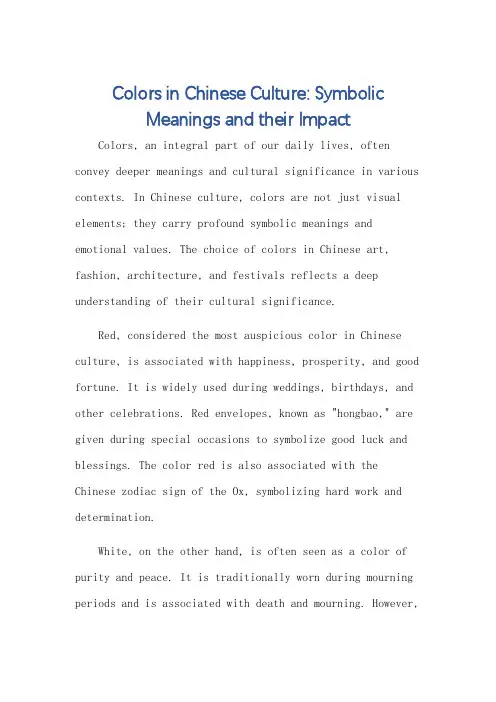
Colors in Chinese Culture: SymbolicMeanings and their ImpactColors, an integral part of our daily lives, often convey deeper meanings and cultural significance in various contexts. In Chinese culture, colors are not just visual elements; they carry profound symbolic meanings and emotional values. The choice of colors in Chinese art, fashion, architecture, and festivals reflects a deep understanding of their cultural significance.Red, considered the most auspicious color in Chinese culture, is associated with happiness, prosperity, and good fortune. It is widely used during weddings, birthdays, and other celebrations. Red envelopes, known as "hongbao," are given during special occasions to symbolize good luck and blessings. The color red is also associated with the Chinese zodiac sign of the Ox, symbolizing hard work and determination.White, on the other hand, is often seen as a color of purity and peace. It is traditionally worn during mourning periods and is associated with death and mourning. However,it is also used to symbolize the purity of snow and is often seen in Chinese landscapes.Black, in Chinese culture, is often associated with darkness and negativity. However, it is also seen as a symbol of elegance and sophistication. Black is often used in traditional Chinese ink paintings to create a sense of mystery and depth.Green, representative of nature and harmony, is highly valued in Chinese culture. It symbolizes growth, fertility, and prosperity. Green is often used in Chinese gardens and landscapes to create a sense of tranquility and balance.Yellow, considered the color of the emperor in ancient China, symbolizes power, dignity, and respect. It is often associated with the royal family and is used in temples and palaces to show respect and reverence. Yellow is also seen as a symbol of wisdom and knowledge.Blue, though less commonly used in traditional Chinese art, is associated with stability, loyalty, and trustworthiness. It is often seen in Chinese porcelain and is considered a calming color that promotes tranquility and peace.In conclusion, colors play a crucial role in Chinese culture, carrying symbolic meanings and emotional valuesthat reflect the values and beliefs of the Chinese people. The choice of colors in Chinese art, fashion, architecture, and festivals is a testament to the rich and diversecultural heritage of China.**中国文化中的色彩:象征意义及其影响**色彩,作为我们日常生活中不可或缺的一部分,往往在不同的语境中传达出更深层的含义和文化意义。

颜色在英语中的文化知识颜色在英语中的文化知识非常丰富。
以下是一些关于颜色的英语表达及其文化背景:1. Red(红色):红色通常与爱情、激情和能量相关联。
在中国文化中,红色代表喜庆、好运和繁荣。
在西方文化中,红色也与圣诞节和情人节等节日有关。
2. White(白色):白色通常与纯洁、无暇和神圣相关联。
在中国文化中,白色用于丧葬仪式,表示哀悼和尊重。
在西方文化中,白色是婚礼的传统颜色,象征纯洁和幸福。
3. Black(黑色):黑色通常与悲伤、死亡和神秘相关联。
在中国文化中,黑色用于丧葬仪式,表示哀悼和尊重。
在西方文化中,黑色也与葬礼有关,但在某些场合,如晚宴或正式活动,黑色被视为优雅和高贵的颜色。
4. Blue(蓝色):蓝色通常与宁静、和平和忠诚相关联。
在中国文化中,蓝色代表天空和海洋,象征着广阔无垠和无限可能。
在西方文化中,蓝色也与忠诚和信任有关,如“忠诚如蓝色”的说法。
5. Green(绿色):绿色通常与自然、生命和希望相关联。
在中国文化中,绿色代表春天和新生活,象征着生机勃勃和希望。
在西方文化中,绿色也与环保和可持续发展有关。
6. Yellow(黄色):黄色通常与智慧、快乐和阳光相关联。
在中国文化中,黄色代表皇家和贵族,象征着权力和财富。
在西方文化中,黄色也与快乐和活力有关,如“欢乐的黄色”的说法。
7. Brown(棕色):棕色通常与地球、稳定和可靠相关联。
在中国文化中,棕色代表土地和丰收,象征着勤劳和节俭。
在西方文化中,棕色也与自然和舒适有关。
8. Pink(粉色):粉色通常与温柔、浪漫和女性相关联。
在中国文化中,粉色代表柔和和温馨,象征着女性的柔情和美丽。
在西方文化中,粉色也与少女心和甜蜜的爱情有关。
9. Purple(紫色):紫色通常与神秘、奢华和权力相关联。
在中国文化中,紫色代表皇室和贵族,象征着高贵和尊贵。
在西方文化中,紫色也与神秘和创造力有关。
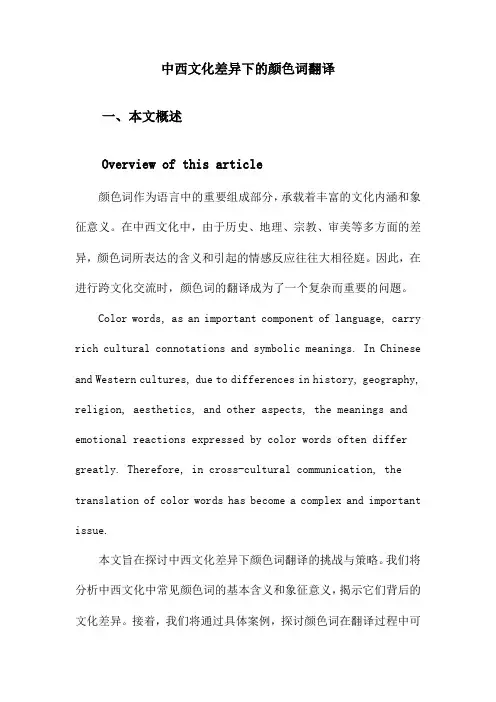
中西文化差异下的颜色词翻译一、本文概述Overview of this article颜色词作为语言中的重要组成部分,承载着丰富的文化内涵和象征意义。
在中西文化中,由于历史、地理、宗教、审美等多方面的差异,颜色词所表达的含义和引起的情感反应往往大相径庭。
因此,在进行跨文化交流时,颜色词的翻译成为了一个复杂而重要的问题。
Color words, as an important component of language, carry rich cultural connotations and symbolic meanings. In Chinese and Western cultures, due to differences in history, geography, religion, aesthetics, and other aspects, the meanings and emotional reactions expressed by color words often differ greatly. Therefore, in cross-cultural communication, the translation of color words has become a complex and important issue.本文旨在探讨中西文化差异下颜色词翻译的挑战与策略。
我们将分析中西文化中常见颜色词的基本含义和象征意义,揭示它们背后的文化差异。
接着,我们将通过具体案例,探讨颜色词在翻译过程中可能遇到的问题,如直译导致的意义失真、文化误解等。
在此基础上,我们将提出相应的翻译策略,如采用意译、增译、减译等方法,以更好地传达颜色词在中西文化中的真实含义和象征意义。
This article aims to explore the challenges and strategies of translating color words under the cultural differences between China and the West. We will analyze the basic meanings and symbolic meanings of common color words in Chinese and Western cultures, and reveal the cultural differences behind them. Next, we will explore the possible problems that color words may encounter in the translation process through specific cases, such as meaning distortion and cultural misunderstandings caused by literal translation. On this basis, we will propose corresponding translation strategies, such as using free translation, additional translation, and subtractive translation, to better convey the true meaning and symbolic significance of color words in Chinese and Western cultures.通过本文的研究,我们期望能够增进对中西文化差异下颜色词翻译的理解,提高翻译质量和效果,促进跨文化交流的顺利进行。
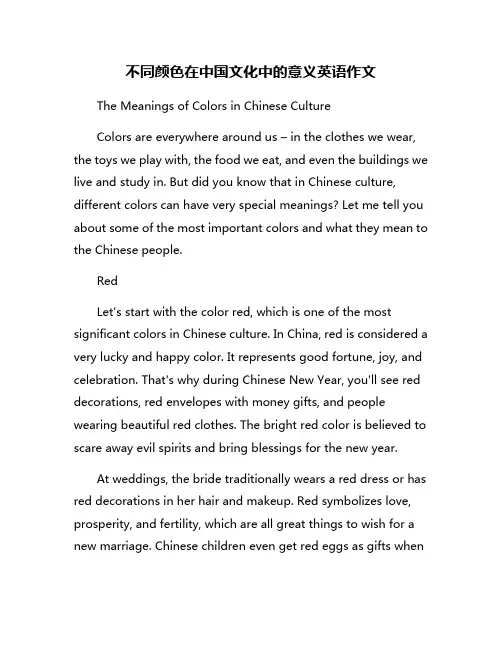
不同颜色在中国文化中的意义英语作文The Meanings of Colors in Chinese CultureColors are everywhere around us – in the clothes we wear, the toys we play with, the food we eat, and even the buildings we live and study in. But did you know that in Chinese culture, different colors can have very special meanings? Let me tell you about some of the most important colors and what they mean to the Chinese people.RedLet's start with the color red, which is one of the most significant colors in Chinese culture. In China, red is considered a very lucky and happy color. It represents good fortune, joy, and celebration. That's why during Chinese New Year, you'll see red decorations, red envelopes with money gifts, and people wearing beautiful red clothes. The bright red color is believed to scare away evil spirits and bring blessings for the new year.At weddings, the bride traditionally wears a red dress or has red decorations in her hair and makeup. Red symbolizes love, prosperity, and fertility, which are all great things to wish for a new marriage. Chinese children even get red eggs as gifts whenthey are born to wish them a bright future filled with happiness and success.YellowAnother color with special meaning is yellow. For the Chinese, yellow is a royal color associated with the emperor and power. In ancient times, only the emperor and his family were allowed to wear yellow clothes and use yellow decorations in the palace. That's because yellow represented dignity, wealth, and status.Today, yellow still has positive meanings like energy, wisdom, and happiness. You might see yellow decorations during special occasions to represent these good wishes. However, too much yellow can sometimes seem overpowering or gaudy, so it's best used in moderation.GreenWhat about the color green? In Chinese culture, green represents growth, harmony, and new beginnings. It's considered a very refreshing and peaceful color that makes people feel calm and balanced. Green is often used in decorations during spring festivals to celebrate the return of nature after the cold winter months.Since green symbolizes life and renewal, it's also a popular color choice for environmentally-friendly products and businesses that want to show their care for the planet. You might see a lot of green logos and packaging for organic foods oreco-friendly companies.WhiteWhite is a very pure and clean color in Chinese culture. It represents purity, brightness, and perfection. White is commonly seen at weddings, where the bride often carries a bouquet of white flowers as a symbol of her innocence and the start of a new, unblemished life with her husband.However, white can also represent death and mourning in certain situations. At funerals, the Chinese sometimes wear white clothing to honor the deceased and express their grief. But in general, white is considered a positive color associated with light, peace, and new beginnings.BlackOn the other hand, the color black has mostly negative meanings in traditional Chinese culture. Black is the color of darkness, evil, and bad luck. It represents destruction, fear, andsadness. That's why you'll rarely see black decorations or clothing at celebratory events like weddings and festivals.However, black can also sometimes represent power, strength, and wealth, especially when combined with other colors like red or gold. But in general, the Chinese prefer to avoid using too much black, especially in important situations where they want to attract positive energy and fortune.BlueFinally, let's talk about the color blue. In China, blue is often associated with immortality, healing, and good health. It represents the sky, water, and nature's life-giving forces. Blue is considered a calming and peaceful color that can help reduce stress and create a sense of tranquility.However, blue can also sometimes have negative meanings related to sadness, coldness, or losing one's way. But overall, blue is a positive color that symbolizes endurance, persistence, and the ability to overcome challenges and hardships in life.So as you can see, colors are not just for decoration in Chinese culture – they carry deep symbolic meanings passed down through centuries of tradition and belief. From the lucky red of Chinese New Year to the purity of white weddings, colorsplay an important role in celebrating special occasions and expressing cultural values.The next time you see a colorful Chinese decoration or outfit, remember the rich meanings behind each vibrant shade. Colors in Chinese culture are like a secret language that speaks volumes about the hopes, dreams, and spiritual beliefs of a people with a long and fascinating history. Isn't that amazing?。
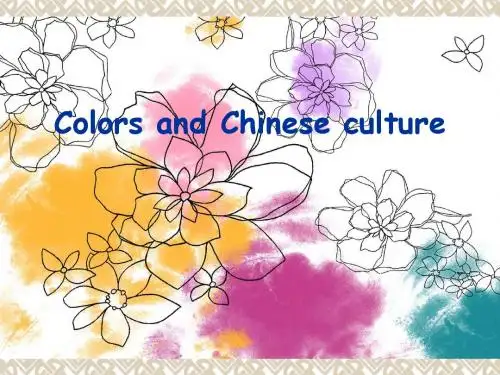
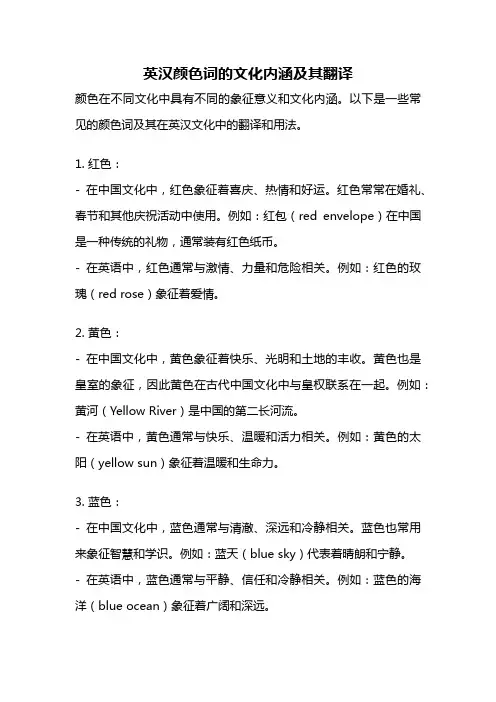
英汉颜色词的文化内涵及其翻译颜色在不同文化中具有不同的象征意义和文化内涵。
以下是一些常见的颜色词及其在英汉文化中的翻译和用法。
1. 红色:- 在中国文化中,红色象征着喜庆、热情和好运。
红色常常在婚礼、春节和其他庆祝活动中使用。
例如:红包(red envelope)在中国是一种传统的礼物,通常装有红色纸币。
- 在英语中,红色通常与激情、力量和危险相关。
例如:红色的玫瑰(red rose)象征着爱情。
2. 黄色:- 在中国文化中,黄色象征着快乐、光明和土地的丰收。
黄色也是皇室的象征,因此黄色在古代中国文化中与皇权联系在一起。
例如:黄河(Yellow River)是中国的第二长河流。
- 在英语中,黄色通常与快乐、温暖和活力相关。
例如:黄色的太阳(yellow sun)象征着温暖和生命力。
3. 蓝色:- 在中国文化中,蓝色通常与清澈、深远和冷静相关。
蓝色也常用来象征智慧和学识。
例如:蓝天(blue sky)代表着晴朗和宁静。
- 在英语中,蓝色通常与平静、信任和冷静相关。
例如:蓝色的海洋(blue ocean)象征着广阔和深远。
4. 绿色:- 在中国文化中,绿色象征着生机、健康和自然。
绿色也与幸运和财富相关,因此在中国人的传统婚礼上,新娘通常会穿绿色的婚纱。
例如:绿茶(green tea)在中国被视为一种健康饮品。
- 在英语中,绿色通常与自然、希望和新生相关。
例如:绿色的草地(green grass)代表着生机和活力。
5. 白色:- 在中国文化中,白色通常与纯洁、幸福和悼念相关。
白色在中国的葬礼中被广泛使用,代表着对逝者的尊重。
例如:白色的鸽子(white dove)象征着和平与纯洁。
- 在英语中,白色通常与纯洁、清晰和无辜相关。
例如:白色的雪花(white snowflake)代表着纯净和洁白。
需要注意的是,颜色的具体文化内涵和象征意义在不同文化中可能有所不同,因此在进行颜色词翻译时需根据具体语境进行合适的表达。
中国文化中颜色代表含义英语作文English: In Chinese culture, colors hold significant meanings and symbolism. Red, for example, is the color of good luck, happiness, and prosperity. It is commonly used during festivities and weddings to bring joy and blessings. Yellow is associated with royalty and power, commonly worn by emperors in ancient times. White represents purity, cleanliness, and mourning, often seen in funerals and used in religious ceremonies. Black symbolizes solemnity, formality, and elegance, often worn during important events and ceremonies. Blue represents calmness, stability, and tranquility, often used in traditional Chinese paintings to depict landscapes and scenes of nature. Finally, green is the color of growth, vitality, and harmony, symbolizing health and prosperity. Overall, colors in Chinese culture play a crucial role in conveying emotions, values, and beliefs.中文翻译: 在中国文化中,颜色具有重要的含义和象征意义。
中英民族文化差异翻译“红”“白”“黑”周小湣摘 要: 因民族历史文化、政治、宗教、习俗和社会环境等因素的影响,汉英两民族的颜色观有所不同,所以翻译颜色词往往不是直译。
同时,由于文化趋同性和文化的交流,两种语言所反映的颜色观逐渐有相似或叠合的现象,也是翻译工作者不可忽视的问题。
本文根据中英民族文化不同分析颜色词的翻译,重点选取了“红”“白”“黑”三色。
关 键 词: 民族文化; 颜色观; 颜色词作者简介: 周小湣,福建儿童发展职业学院外语系(福建 福州 350013)引言:科学研究表明,除色盲外,人类观察颜色的视觉系统在生理上并无区别,汉语中常用的颜色词如红、橙、黄、绿、青、蓝、紫、白、黑、灰等在英语中都有其大体相对词:red、orange、yellow、green、blue、purple、white、black、gray等,所以翻译时可以直译。
比如:樱花红陌上,柳叶绿池边。
The pathways red with cherry blossoms,The lakeside green with willow leaves.英国语言学家莱昂斯(J.Lyons)认为不同语言对颜色的不同的切分同各种语言所负荷的不同文化有关。
据统计,汉语中有表示红色的词语“绯红”“猩红”“嫣红”等四十多个,可英语中仅表示“粉红色”之意的词语就有三十多个,而表示红色的词语则多达一百来个。
由此可见,在不同语言里表示同一“色相”的颜色词在所指的数量与范围方面存在差异,所以翻译时要特别注意。
而且,即使是同一颜色,通过不同民族的人认知与体验表达出来,必定会因人而异。
如果把语言和民族文化比做冰山的话,那语言就是露出水面的冰山一角,隐藏水下的巨大主体是民族文化如宗教信仰、价值观、习俗、生活方式等。
翻译是两种语言的转换,自然就不可避免的在语言转换的同时进行文化的转换。
翻译颜色词也是如此,颜色词所蕴涵的意义是一个民族“心灵的形象呈现”。
我们发现中英两个民族对色彩的界定,尤其是对颜色词所代表的象征意义各有不同,所以如不从民族文化方面考虑,翻译就无从下手。
中国文化中颜色代表含义英语作文Colors in Chinese CultureMy name is Xiaoming and I'm 10 years old. I love learning about the rich culture and traditions of China. One thing I find really fascinating is how different colors have special meanings in Chinese culture. Let me tell you about some of the most important colors and what they represent.RedThe color red is extremely important and lucky in Chinese culture. It symbolizes happiness, good luck, and prosperity. That's why red is used a lot during the Chinese New Year celebrations. Houses are decorated with red lanterns, red scrolls with couplets, and red envelopes filled with money are given as gifts. Brides wear red dresses on their wedding days for good luck. Even babies are given red eggs and red hats after they are born to protect them from evil spirits. Whenever I see bright red things, it makes me feel joyful and optimistic.YellowYellow is another really meaningful color in China. It is considered the noblest color and represents neutrality, wisdom, and royalty. In ancient times, only the emperor was allowed towear yellow robes and live in the Yellow Palace. Many important buildings in the Forbidden City have yellow glazed roof tiles. Dragon robes with yellow decorations were exclusively worn by emperors on special occasions. Some of my favorite characters in kung fu stories are the legendary Yellow Emperor and the Monkey King with his yellow cape. Whenever I see yellow, it makes me think of wise rulers and powerful heroes.GreenThe color green is very connected to nature in Chinese culture. It represents growth, harmony, fertility, and good health. In the spring, all the new green leaves coming out is a beautiful sight that fills me with energy. Green jade stone is highly prized and considered very valuable, partly because of its gorgeous green color. Green hats were worn by scholars who passed the imperial exams to become government officials. Even today, environmentally-friendly practices that help nature flourish are called "going green." Seeing lush greenery always lifts my spirits and reminds me of peaceful times.WhiteWhite is a very pure and clean color in Chinese beliefs. It symbolizes purity, brightness, and fulfillment. White jade is treasured as much as green jade. Many gods and goddesses aredepicted wearing white robes. At Chinese weddings, a white rooster is included because the color represents fertility and new beginnings for the couple. White chrysanthemums are popular flowers that represent wholeness and perfection. The White Lotus Society were a group who sought spiritual enlightenment. Whenever I think of white, it makes me imagine things that are sacred and unblemished.BlackIn contrast to white, the color black has some negative meanings associated with it, although not entirely. Black can represent power, strength, and unhappiness. People wear black clothes at funerals to show they are in a period of mourning. Black flags are symbols of giving up or resigning. The Black Society were a group of people who didn't follow traditional values. However, black lacquerware is very elegant, and having black hair is considered attractive. Seeing the color black doesn't always make me feel gloomy as long as it's used in an artistic way.BlueThe color blue doesn't have as many special meanings compared to other colors, but it is still significant. In general, blue represents heaven, immortality, and wood. Ming dynastyvases with beautiful blue decorations are highly prized. The Blue Dragon is one of the most powerful creatures in Chinese mythology that controls the waters. There are many temples with blue roofs that look so graceful. When I gaze at the blue sky on a sunny day, it fills me with tranquility and thoughts about the wonders of nature.Those are some of the key colors and what they mean in Chinese culture. As you can see, colors play such an important role and each one has deep symbolic meaning. From the brilliant red of firecrackers to the calming blue of ancient pottery, the colors make me appreciate the richness of my heritage. I hope you found learning about the meanings of colors in China as fascinating as I do!。
英汉颜色词的文化内涵及其翻译颜色词在不同文化中具有不同的内涵和象征意义。
以下是一些常见的颜色词及其文化内涵和翻译。
1. 红色(Red):文化内涵:红色在中国文化中象征吉祥、喜庆和热情。
它常被用于庆祝节日和婚礼,也代表着幸福和好运。
另一方面,在西方文化中,红色通常与爱、激情和力量相关联。
翻译:Red例句:- 中国春节期间,人们会戴红色的衣物和饰品。
(During Chinese New Year, people wear red clothes and accessories.)- 红色玫瑰象征着爱情和浪漫。
(Red roses symbolize love and romance.)2. 黄色(Yellow):文化内涵:在中国文化中,黄色代表着皇室的权力和地位,也象征着丰收和富裕。
另一方面,在西方文化中,黄色通常与快乐、温暖和活力相关联。
翻译:Yellow例句:- 中国传统文化中,黄色是皇家的颜色。
(In traditionalChinese culture, yellow is the color of royalty.)- 这个房间的墙壁涂成了明亮的黄色。
(The walls of this room are painted in a bright yellow color.)3. 蓝色(Blue):文化内涵:蓝色在西方文化中通常被视为冷静、平静和信任的象征。
它也与水和天空相关联。
在中国文化中,蓝色通常与生气勃勃和健康相关联。
翻译:Blue例句:- 我喜欢在晴朗的天空下看蓝色的海洋。
(I love looking at the blue ocean under a clear sky.)- 这个房间的墙壁漆成了深蓝色,给人一种宁静的感觉。
(The walls of this room are painted in a deep blue color, givinga sense of tranquility.)4. 绿色(Green):文化内涵:绿色在许多文化中都被视为生命、自然和希望的象征。
从颜色词看中英文化差异
中国文化对颜色有着独特的理解和赋予,与英文文化存在一些差异。
下面是一些常见颜色词在中英文化中的差异:
1. 红色 (Red):在中国文化中,红色代表着喜庆、热情、吉祥和好运。
红色是中国文化中最喜欢的颜色,常用于喜庆的场合,如婚礼和春节。
而在英文文化中,红色通常与爱情、激情和力量相关。
2. 黄色 (Yellow):在中国文化中,黄色象征着皇权和尊贵。
中国古
代帝王常使用黄色作为皇家颜色。
黄色还象征着丰收和土地的肥沃。
而在
英文文化中,黄色通常与太阳、温暖、快乐和活力相关。
3. 白色 (White):在中国文化中,白色代表着清白、纯洁和丧事悼念。
白色常用于婚礼中新娘的婚纱以及葬礼上的丧服。
而在英文文化中,
白色通常与纯洁和无暇相关。
4. 蓝色 (Blue):在中国文化中,蓝色常与男性相关,代表着清澈和
纯净。
而在英文文化中,蓝色通常与忧郁和冷静相关,例如“Monday blues”表示星期一的低落情绪。
5. 绿色 (Green):在中国文化中,绿色与春天、生命和希望相关,
被视为吉祥的颜色。
而在英文文化中,绿色通常与自然、环保和生态相关,也与嫉妒相关(green with envy)。
这些是一些常见颜色词在中英文化中的差异。
颜色的文化赋予不仅体
现了不同的情绪和象征意义,也反映了不同文化对生活和世界的认知和态度。
浅议中西方文化中颜色词的翻译刘静波(湖南司法警官职业学院湖南长沙410131)摘要:中西方文化中表示颜色的词语都很丰富,在汉英语言翻译中,我们不仅要注意观察它们本身的意义,更要留心它们深广的象征意义。
因为各民族文化、地理位置、历史传统、宗教信仰、审美心理等千差万别,各种颜色词对于不同民族的人而言,在视觉和心理上所引发的象征意义也不尽相同。
翻译时,我们应特别注意其中的差异。
该文试从中西方文化中颜色词的象征意义这一角度,探讨一下如何巧译颜色词。
颜色词;汉语;英语;象征意义;翻译关键词:赤橙黄绿青兰紫,客观世界五彩缤纷。
在人类丰富的语言中,颜色词表现出的独特魅力,是令人刮目相看的。
不同的民族由于生活环境、心理因素、宗教信仰、思维定势和文化背景的不同,赋予颜色词的语用意义亦不尽相同,这样,颜色词的象征意义在中西方文化之间自然就会产生很大的差异,有的甚至截然相反。
例如美国学者阿思海姆在他的《色彩论》中说过“红色被认为是令人激动的,因为它能使我们想到火、血和革命的含义”。
而从文化人类学角度来说,中国古人认为“日至而万物生”,因而红色代表喜庆和吉祥之意。
所以,汉英语言的颜色词这种不对等不仅表现在颜色概念意义的差异上,更体现在颜色词丰富多彩的内涵和文化色彩的差异上。
本文试图从汉英两种语言中一些基本颜色词的主要象征意义及其所反映出的文化内涵作一些对比和探讨,以求教于同行和读者。
1.红色(red)在中西方语言中,红色往往与庆祝活动和喜庆日子有关,比如,在中国,男娶女嫁要贴大红“双喜(double happiness written in red)”,生意兴旺叫“红火(flourishing)”,表示好运的“红运当头(in luck’s way)”等,这些词在翻译时,“红”如果被简单的译成“red”就很难被英语国家的人们理解,所以翻译这些词时,译出它们的语用意义就便于理解。
在西方文化中red也有表示“隆重”的含义,如We will give him the red-carpet treatment.我们将举行隆重仪式欢迎他;It was a red-letter day for us when Paul came home from the war.保罗从战场回家那天,是我们值得纪念的日子。